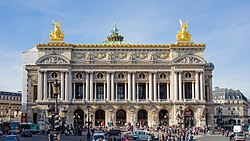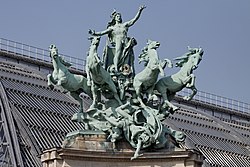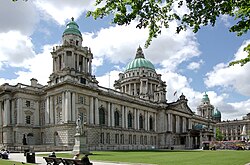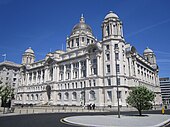
Beaux-Arts architecture was the academic architectural style taught at the École des Beaux-Arts in Paris, particularly from the 1830s to the end of the 19th century. It drew upon the principles of French neoclassicism, but also incorporated Renaissance and Baroque elements, and used modern materials, such as iron and glass, and later, steel. It was an important style in Europe and the Americas through the end of the 19th century, and into the 20th.

Ortaköy is a neighbourhood in the municipality and district of Beşiktaş, Istanbul Province, Turkey. Its population is 9,423 (2022). It is on the European shore of the Bosphorus. it was originally a small fishing village, known in Greek as Agios Fokas in the Byzantine period and then as Mesachorion.

Neo-Byzantine architecture was a revival movement, most frequently seen in religious, institutional and public buildings. It incorporates elements of the Byzantine style associated with Eastern and Orthodox Christian architecture dating from the 5th through 11th centuries, notably that of Constantinople and the Exarchate of Ravenna.

The Széchenyi Medicinal Bath in Budapest is the largest medicinal bath in Europe. Its water is supplied by two thermal springs, their temperature is 74 °C (165 °F) and 77 °C (171 °F).

Buda Castle is the historical castle and palace complex of the Hungarian Kings in Budapest. It was first completed in 1265, although the massive Baroque palace today occupying most of the site was built between 1749 and 1769. The complex in the past was referred to as either the Royal Palace or the Royal Castle. The castle now houses the Hungarian National Gallery and the Budapest Historical Museum.

The Gresham Palace (Gresham-palota) is a building in Budapest, Hungary; it is an example of Art Nouveau architecture. Completed in 1906 as an office and apartment building, it is today the Four Seasons Hotel Budapest Gresham Palace, a luxury hotel managed by Four Seasons Hotels. It is located along the River Danube, adjacent to Széchenyi Square and the eastern terminus of the Széchenyi Chain Bridge.

Ortaköy Mosque, formally the Büyük Mecidiye Camii in Beşiktaş, Istanbul, Turkey, is a mosque situated at the waterside of the Ortaköy pier square, one of the most popular locations on the Bosphorus. It was commissioned by the Ottoman sultan Abdülmecid I and its construction was completed around 1854 or 1856.

Moorish Revival or Neo-Moorish is one of the exotic revival architectural styles that were adopted by architects of Europe and the Americas in the wake of Romanticist Orientalism. It reached the height of its popularity after the mid-19th century, part of a widening vocabulary of articulated decorative ornament drawn from historical sources beyond familiar classical and Gothic modes. Neo-Moorish architecture drew on elements from classic Moorish architecture and, as a result, from the wider Islamic architecture.

Lipót Baumhorn was a Hungarian architect of Jewish heritage, the most influential Hungarian synagogue architect in the first half of the 20th century. He drew blueprints for about 20 synagogues in the Kingdom of Hungary.
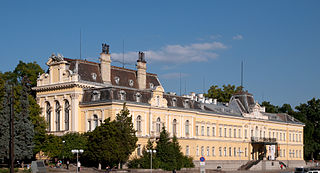
Friedrich Grünanger was a Transylvanian Austrian architect who worked primarily in Bulgaria.

Fellner & Helmer was an architecture studio founded in 1873 by Austrian architects Ferdinand Fellner and Hermann Helmer.
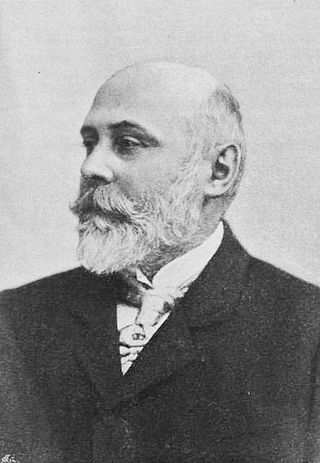
Ödön Lechner was a Hungarian architect, one of the prime representatives of the Hungarian Szecesszió style, which was related to Art Nouveau in the rest of Europe, including the Vienna Secession. He is famous for decorating his buildings with Zsolnay tile patterns inspired by old Magyar and Turkic folk art, which are combined with modern materials such as iron.

Alajos Hauszmann was a Hungarian architect, professor, and member of the Hungarian Academy of Sciences.

Alexandre Vallaury (1850–1921) was a French-Ottoman architect who established architectural education in the Ottoman Empire at the School of Fine Arts in Constantinople. Nicknamed "architect of the city" by Osman Hamdi Bey, Vallaury, alongside his collaborator and palace architect Raimondo D'Aronco, was a leading practitioner of Orientalist eclecticism.
The architecture of Hungary is understood as the architecture of the territory of the country of Hungary, and in a wider, of the Kingdom of Hungary, from the conquest to the present day.
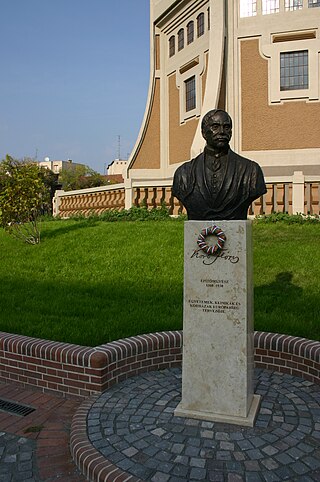
Flóris Korb was a Hungarian architect.

Edwardian architecture usually means a Neo-Baroque architectural style that was popular for public buildings in the British Empire during the Edwardian era (1901–1910). Architecture up to the year 1914 may also be included in this style.

Josip Vancaš was an Austro-Hungarian and Yugoslav architect who spent most of his career in the Bosnian city of Sarajevo, where he designed over two hundred buildings. He also designed important buildings in present-day Croatia and Slovenia. He was also the first conductor of the Männer-gesang-verein in Sarajevo, at its founding in 1887.

The Danube Palace is a Neo-Baroque concert hall located in the Inner City of Budapest, Hungary. It was built between 1883 and 1885 according to the plans of Vilmos Freund. It was known as the casino of Lipótváros – not in the sense of gambling - but an aristocratic club for entertainment. The Palace served as a place of culture, supporting many young artists. Bartók, Kodály, and Dvorák all played in its first-class concert hall. Since 1951 the building has been carrying out the cultural programs of the Ministry of Internal Affairs. It is home to the Danube Symphony Orchestra.
